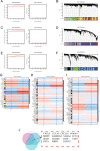CXCL10 as a shared specific marker in rheumatoid arthritis and inflammatory bowel disease and a clue involved in the mechanism of intestinal flora in rheumatoid arthritis
- PMID: 37328529
- PMCID: PMC10276029
- DOI: 10.1038/s41598-023-36833-7
CXCL10 as a shared specific marker in rheumatoid arthritis and inflammatory bowel disease and a clue involved in the mechanism of intestinal flora in rheumatoid arthritis
Abstract
This study aimed to identify shared specific genes associated with rheumatoid arthritis (RA) and inflammatory bowel disease (IBD) through bioinformatic analysis and to examine the role of the gut microbiome in RA. The data were extracted from the 3 RA and 1 IBD gene expression datasets and 1 RA gut microbiome metagenomic dataset. Weighted correlation network analysis (WGCNA) and machine learnings was performed to identify candidate genes associated with RA and IBD. Differential analysis and two different machine learning algorithms were used to investigate RA's gut microbiome characteristics. Subsequently, the shared specific genes related to the gut microbiome in RA were identified, and an interaction network was constructed utilizing the gutMGene, STITCH, and STRING databases. We identified 15 candidates shared genes through a joint analysis of the WGCNA for RA and IBD. The candidate gene CXCL10 was identified as the shared hub gene by the interaction network analysis of the corresponding WGCNA module gene to each disease, and CXCL10 was further identified as the shared specific gene by two machine learning algorithms. Additionally, we identified 3 RA-associated characteristic intestinal flora (Prevotella, Ruminococcus, and Ruminococcus bromii) and built a network of interactions between the microbiomes, genes, and pathways. Finally, it was discovered that the gene CXCL10 shared between IBD and RA was associated with the three gut microbiomes mentioned above. This study demonstrates the relationship between RA and IBD and provides a reference for research into the role of the gut microbiome in RA.
© 2023. The Author(s).
Conflict of interest statement
The authors declare no competing interests.
Figures









Similar articles
-
Data-driven multiple-level analysis of gut-microbiome-immune-joint interactions in rheumatoid arthritis.BMC Genomics. 2019 Feb 11;20(1):124. doi: 10.1186/s12864-019-5510-y. BMC Genomics. 2019. PMID: 30744546 Free PMC article.
-
Comprehensive analysis revealed the immunoinflammatory targets of rheumatoid arthritis based on intestinal flora, miRNA, transcription factors, and RNA-binding proteins databases, GSEA and GSVA pathway observations, and immunoinfiltration typing.Hereditas. 2024 Jan 25;161(1):6. doi: 10.1186/s41065-024-00310-6. Hereditas. 2024. PMID: 38273392 Free PMC article.
-
An Increased Abundance of Clostridiaceae Characterizes Arthritis in Inflammatory Bowel Disease and Rheumatoid Arthritis: A Cross-sectional Study.Inflamm Bowel Dis. 2019 Apr 11;25(5):902-913. doi: 10.1093/ibd/izy318. Inflamm Bowel Dis. 2019. PMID: 30321331 Free PMC article.
-
Gut microbiota and rheumatoid arthritis: From pathogenesis to novel therapeutic opportunities.Front Immunol. 2022 Sep 8;13:1007165. doi: 10.3389/fimmu.2022.1007165. eCollection 2022. Front Immunol. 2022. PMID: 36159786 Free PMC article. Review.
-
Gut microbiome in chronic rheumatic and inflammatory bowel diseases: Similarities and differences.United European Gastroenterol J. 2019 Oct;7(8):1008-1032. doi: 10.1177/2050640619867555. Epub 2019 Aug 1. United European Gastroenterol J. 2019. PMID: 31662859 Free PMC article.
Cited by
-
Associations between gut microbiome and circulating cytokines: a cross-sectional analysis in the FINRISK 2002 population cohort.Gut Pathog. 2025 Aug 26;17(1):66. doi: 10.1186/s13099-025-00742-z. Gut Pathog. 2025. PMID: 40859402 Free PMC article.
-
Comparison of volumetric brain analysis in subjects with rheumatoid arthritis and ulcerative colitis.Front Med (Lausanne). 2024 Nov 20;11:1468910. doi: 10.3389/fmed.2024.1468910. eCollection 2024. Front Med (Lausanne). 2024. PMID: 39635596 Free PMC article.
-
Integrative RNA, miRNA, and 16S rRNA sequencing reveals immune-related regulation network for glycinin-induced enteritis in hybrid yellow catfish, Pelteobagrus fulvidraco ♀ × Pelteobagrus vachelli ♂.Front Immunol. 2025 Jan 15;15:1475195. doi: 10.3389/fimmu.2024.1475195. eCollection 2024. Front Immunol. 2025. PMID: 39882244 Free PMC article.
References
Publication types
MeSH terms
Substances
LinkOut - more resources
Full Text Sources
Medical

